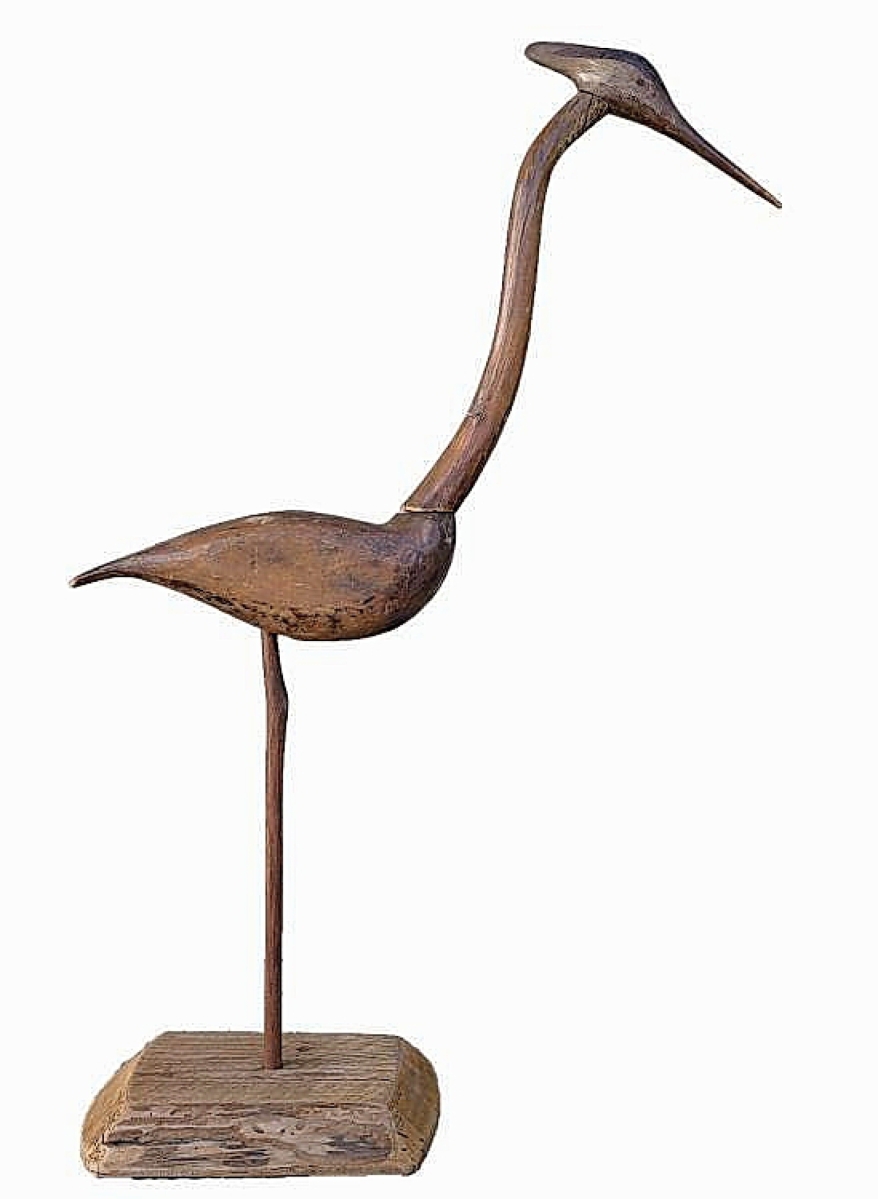
Deservedly, it was the star of the sale, selling for $192,000, more than $100,000 over the estimate. The Great Blue Heron decoy is a wonderful piece of folk art made by an unknown New Jersey carver. It was part of the Mackey collection but not sold when most of the collection was dispersed in the 1970s. It remained in the Mackey family until being consigned for this sale. It was well-known to collectors, having been exhibited often and the catalog description, four pages long, provides the context for the decoy.
Review by Rick Russack, Photos Courtesy Guyette & Deeter
ST MICHAELS, MD. – Although dozens of decoys carved by recognized masters of the craft sold for five- and six-figure prices, it was an exceptional example of a great blue heron decoy by an unknown New Jersey maker that finished at $192,000 at Guyette & Deeter’s April 30-May 1 sale. Deservedly, it was the top price of the two-day auction, which also saw a fish decoy bring more than $100,000. Another decoy by an unknown maker, a shorebird, finished at $33,600. Sporting art was well represented, with an oil painting by Lynn Bogue Hunt of mallards in flight bringing $33,600. Also included was a mechanical owl decoy, miniatures and decorative carvings, several duck calls, Nantucket baskets, firearms-related advertising, powder tins and much more. Five decoys sold for more than $100,000 and another 78 decoys earned five-figure prices. The sale, 98.5 percent sold, totaled slightly under $4 million. Three world records were set for fish decoys, along with records for Louisiana decoys, Nova Scotia decoys, and there were others.
To accommodate Covid-19 restrictions, the live sale took place without bidders present in the salesroom. Prior to the auction, both Gary Guyette and Jon Deeter took selections of decoys on “road trips” with individual or group previews on request in different geographical areas. Their 365-page color catalog, in many cases, had information and “decoy lore” about carvers and collectors, as well as vintage photographs that were not included in the online descriptions. This sort of information likely would be lost were it not recorded in catalogs like these. In a time when many auctioneers have stopped producing comprehensive catalogs, these are well worth the cost. To compensate for the inability to host a traditional live auction as in the recent past, the company absorbed the additional cost to buyers who utilized the online bidding platforms. Condition reports, online and in the catalog, are guaranteed by the firm.
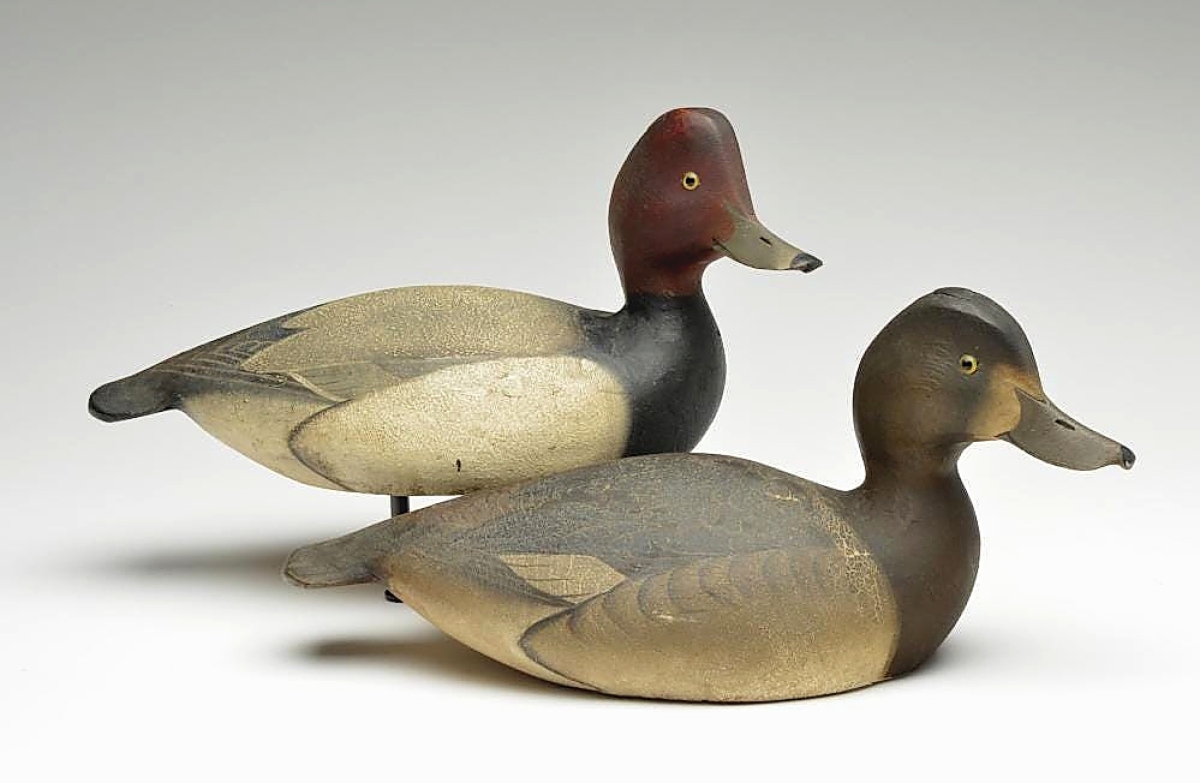
The Ward brothers of Crisfield, Md., made this pair of redheads for Dr Edgar Burke, a close friend and frequent client of theirs. A banner on the underside of the drake reads, “Dr Edgar Burke with the maker’s compliments, LT Ward.” They sold for $126,000.
Selections were drawn from a number of well-known and well-respected collections. Jim Thompson, the longest serving governor of Illinois, actively sought and bought many outstanding decoys made by Illinois carvers. Bruce Williams concentrated on collecting decoys made in New Jersey and those used on the Delaware River and Barnegat Bay. Steve Michaan started collecting fish decoys in 1984, when few others cared. He assembled an outstanding collection and wrote the standard reference works on fish decoys. Gary and Dale Guyette, then antiques dealers living in Maine, made frequent buying trips to the Canadian maritime provinces starting in 1974, and built a collection of that region’s decoys. They have decided to go their separate ways after a long marriage. Together, they wrote the standard reference work on decoys from the maritimes. Their catalog includes more than ten pages of biographical information on the collectors. Guyette’s first decoy auction, in partnership with Jim Julia, took place in 1984 and both termed it “a disaster,” but the business continued and Guyette eventually teamed up with Jon Deeter in 2010.
The catalog description of the heron, the top selling decoy in the sale at $192,000, was four pages long and provided insight as to why it sold for what it brought, exceeding the estimate by more than $100,000. The decoy was part of the famed William Mackey collection, most of which was dispersed in a series of auctions by Cape Cod auctioneer Richard Bourne in 1973 and 1974. It was a historic series of auctions, offering collectors the opportunity to own some of the finest decoys from what is still, nearly 50 years later, regarded as one the best collections ever assembled. But this decoy was not included in those auctions and remained in the Mackey family until it was consigned to this sale. It was well-known to collectors as photos of it had been published numerous times and Mackey exhibited it several others. It was an outstanding piece of folk art, with a hollow body, assembled from four pieces of wood. The neck was a long, separate branch doweled on one end, carved and twisted to create a perfect position for the separate one-piece applied head, which had a carved crest and a carved bill. It was 44 inches tall and showed its age, with minor condition issues. Most of the original paint had weathered away, leaving a surface with a very pleasing patina.
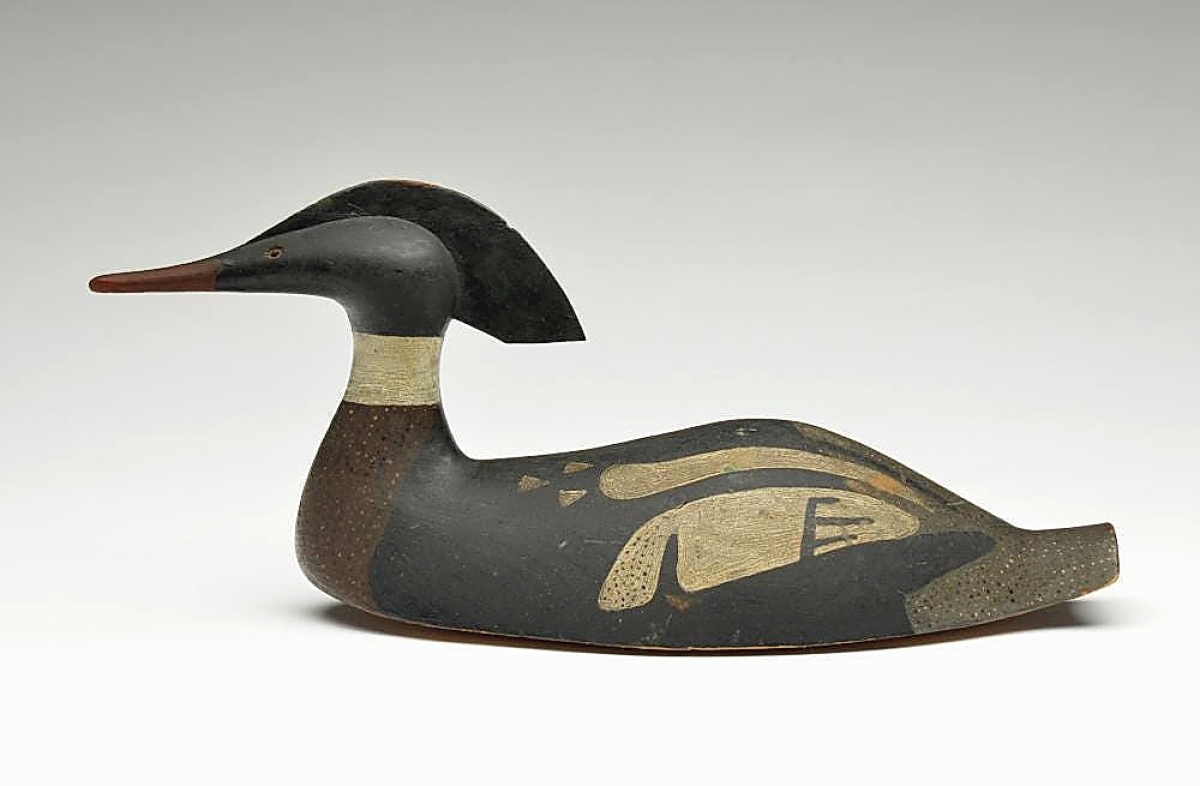
One of several decoys in the sale from the collection of Gary and Dale Guyette, this merganser drake was carved by Captain Edwin Backman of Nova Scotia. The catalog devotes six pages to this decoy, which sold for $120,000, including a detailed biography of the captain, which informs us that he died in a shipwreck in 1915. This decoy is well known to collectors, having been pictured in at least two books.
Heron decoys are uncommon; their main use was as “confidence” decoys, being placed near other decoys to help lure flocks of ducks into range of a hunter’s shotgun. The catalog notes: “useful in their day, today they are treasured for their great rarity and admired for their wonderful sculptural form and imposing presence. This example is perhaps the finest of its kind to have survived.”
The other duck decoys achieving six-figure prices represented differing geographical areas. Selling for $126,000 was a presentation pair of 1936 redheads made by the Ward Brothers of Crisfield, Md. They were made for Dr Edgar Burke, a long-time friend of the brothers, who, in addition to his medical practice, was a hunter, an archeologist and a respected painter of sporting subjects. He owned a number of Ward Brothers decoys, and this pair has a banner on the underside of the drake that reads, “Dr Edgar Burke with the maker’s compliments, LT Ward.” They came from the Mathews estate, and many in that collection had been bought from the Mackey collection, probably in the 1950s. Bringing $120,000 was a merganser drake made by Captain Edwin Backman, Lunenburg, Nova Scotia, in the first quarter of the Twentieth Century. The catalog devotes six pages to this decoy, including a detailed biography of the captain, which informs us that he died in a shipwreck in 1915 when a vessel he commanded was lost at sea. The merganser had carved eyes and an exaggerated wooden crest with the head and crest carved from a single piece of wood. It was from the Guyette collection and was acquired about 1980 shortly after it came out of a home in the area. The decoy is pictured on the front cover of the Guyettes’ book on decoys of the maritime provinces. The other duck decoy bringing top dollar, $108,000, was a swimming greenwing teal drake by John Blair Sr of Philadelphia. It had a two-piece hollow body with painted tack eyes and detailed feather painting on back.
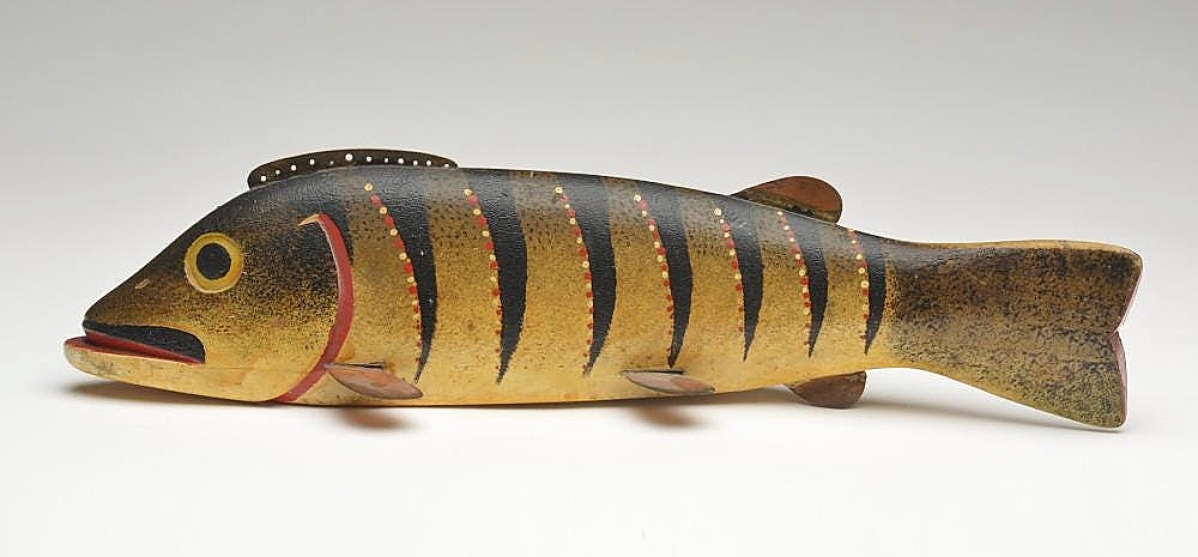
More than doubling the previous record for a fish decoy, this 20-inch carved and painted decoy, the largest known to have been made by Oscar Peterson, sold for $114,000. Two other fish decoys in the sale also set new records.
The paragraph above notes that those six-figure prices were obtained by duck decoys. That’s because the other six-figure price, $114,000, a new auction record for any fish decoy, was earned by an example carved by Oscar Peterson. The catalog also devotes six pages to this decoy and a biography of Peterson. It is believed, at 20 inches long, to be the largest fish decoy ever carved by Peterson of Cadillac, Mich. Peterson had a chronic alcohol problem and was known to trade his decoys for the price of a drink, both at bars in Cadillac and at a sporting goods store where he sold his carvings to the store owner for 30 cents, who then sold them for $1. A four-inch-tall vase, one of just a few known to have been carved by Peterson, sold for $31,200. Peterson used scraps of wood he found, but his work is in the collections of several museums.
Decoys other than ducks and fish also did well. One of the most unusual was a Great Horned owl decoy made by Charles Perdew of Henry, Ill., the only one he is known to have made, which sold for $69,000. It was not an ordinary decoy. Nearly all decoys are static, meaning that although they rise and fall with tides, they are not mechanical; they do not move. This owl, however, did. Its wings were made to flap, activated by a pull string, and, at the same time, the owl’s head would turn to the right as the wings flapped. It had glass eyes, stood 30 inches tall and pheasant feathers surrounding its neck. Perdew made it for Oscar Meyer, a Chicago policeman he befriended after Meyer bought some of his mallard decoys. At one point, when Perdew was short of money and could not afford a new furnace to heat his home, Meyer, without being asked, and with the help of another policeman, bought and installed a furnace for Perdew. When Perdew asked Meyer what he owed him, Meyer, as the story goes, replied. “nothing – make me something.” And so the owl came into being. (This information is from the catalog description, based upon an article by Donna Tonnelli that appeared in a 2013 issue of Decoy Magazine.)
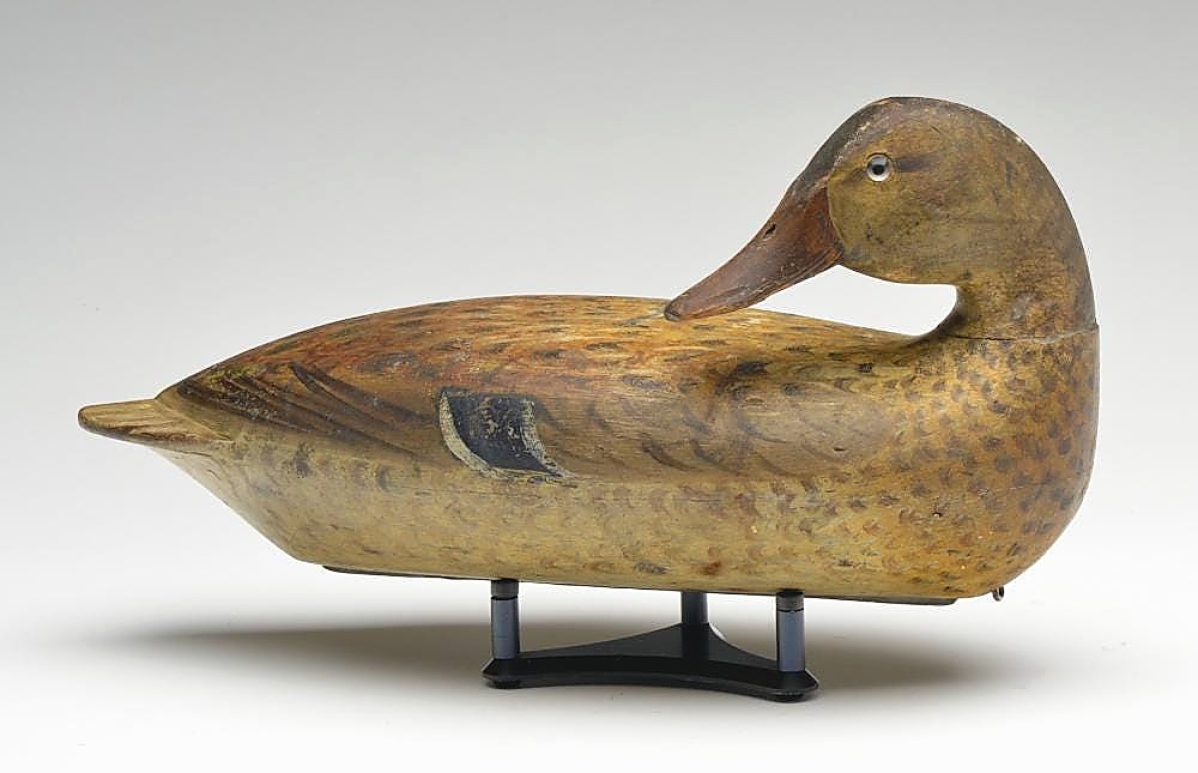
This circa 1900 back-preening mallard hen was carved by Robert Elliston and was one of a small group of decoys found in 2009 by a young couple in the attic of a home they were remodeling. The catalog devotes four pages to this story, and this decoy was sold for $84,000.
A mallard drake, also by Charles Perdew, based upon presale interest was expected to be one of the stars of the sale, and it was, finishing at $43,200. It was from the Governor Jim Thompson collection of Illinois decoys and bore the brand of G.K. Schmidt on the base, having come from the Schmidt rig. This decoy was slightly larger than Perdew’s other decoys, and the paint job was representative of the finest work of Perdew’s wife, Edna. The catalog description of the history of the Schmidt rig of decoys, a long unresolved mystery in the decoy world, is ten pages long and was also written by Donna Tonnelli. Another mallard, a back preening hen by Robert Elliston, also an Illinois carver, and also from the Thompson collection, earned $84,000, the second highest price of the second day of the sale. Decoys by Elliston are not common. When this decoy was offered in a 2010 Guyette and Deeter sale, Thompson, who had started concentrating on decoys by Illinois carvers about eight years earlier, said that Elliston was the only carver missing from his collection. Thompson was advised that this decoy was especially interesting in that it was an example of Elliston’s earliest style of carving. This decoy, others by Elliston and a group of Masons are part of “one of those stories.” The decoys were brought to light in 2009 by a young couple who had found them in the attic of a house they were remodeling. They contacted Joe Tonnelli after seeing an article about Elliston on Tonelli’s website. To make a long story short, they were hoping to get $5,000 to help with the remodeling. Tonelli told them they would get the most money by consigning them to Guyette and Deeter, which they did. And realized more than $150,000. Again, this background information is from the four-page description in the catalog.
It was noted above that a fish decoy by Oscar Peterson sold for $114,000. A 50-inch rainbow trout, probably carved as a trade sign by Peterson, but supposedly traded to the State Street Cafe in Cadillac for a month of free meals, sold for $19,200. Other fish decoys outperformed expectations. A 6½-inch sunfish decoy made by Harry Seymour, Lake Chautauqua, N.Y., sold for $48,000. It had a classic leather tail with tack eyes, carved mouth and a finely painted scale pattern. The gills were carved and painted red. Another Lake Chautauqua fish decoy made by Ed Irwin in the late Nineteenth Century, earned $43,200.
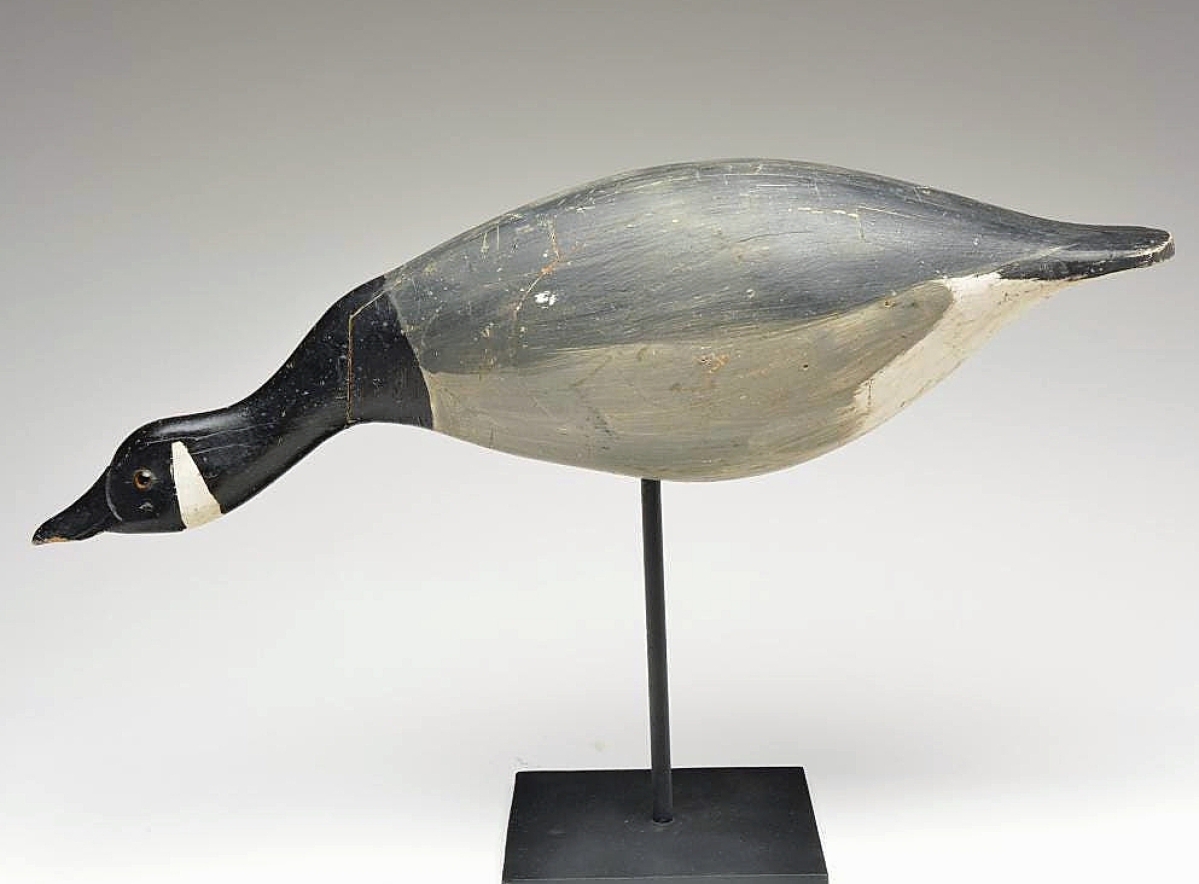
A hollow-carved reaching Canada goose decoy, one of several Canada geese in the sale, sold for $60,000. The laminated decoy was made by John Tax of Osakis, Minn.
The highest priced of the sporting paintings was a large oil on canvas by Lynn Bogue Hunt, which sold for $33,600. Done in the first half of the Twentieth Century, it depicted several mallards in flight with a hunter and his rig of decoys set out. An acrylic on board by David Maass (b 1929) of a flock of broadbills landing on a lake with ice forming on the shore sold over the estimate, finishing at $16,800.
A few days after the sale, Jon Deeter said, “We were really pleased. We had some very special things like the Mackey heron, the grouping of fish decoys, three of which broke the record for a fish decoy we set last November when we sold one for $42,500. We had quite a few new bidders and we sent out 350 invoices for the 600 lots. To me, that says we’re reaching the end-buyers. And for me personally, I love selling things that I really like. I’m looking forward to our summer sale, which will be August 6-7. It will be conducted the same way as this one. We’d love to get back to the actual live sales, but we don’t think we’re there yet.”
Prices given include the buyer’s premium as stated by the auction house. For additional information, call Jon Deeter 440-610-1768 or Gary Guyette, 410-745-0485 or visit their website www.guyetteanddeeter.com.

































